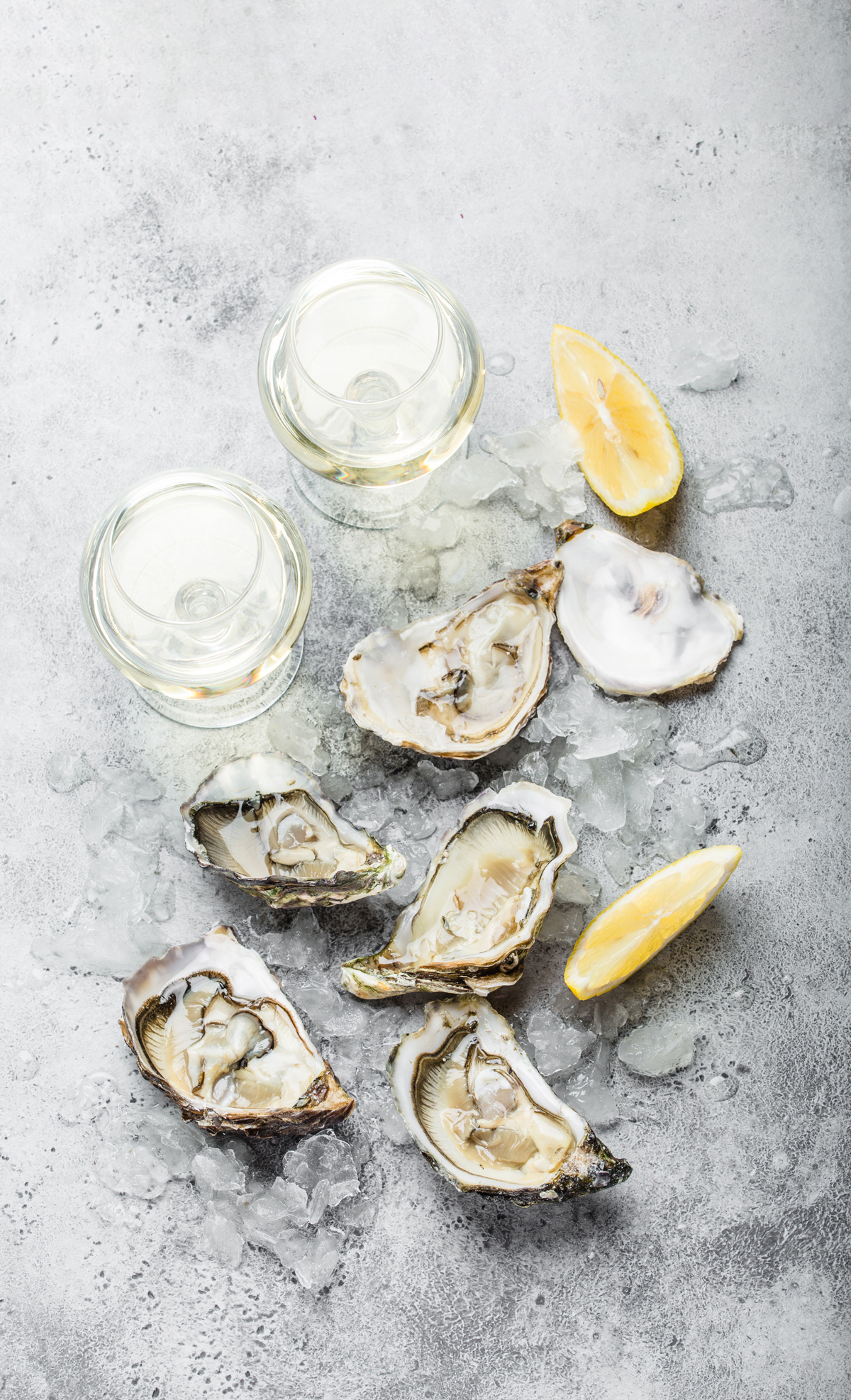
Wine Culture Magazine

What grows together goes together—and that includes Bouziques oysters and Picpoul wines in the coastal areas of France’s Languedoc region. Photo by Tim Pawsey
Summer’s relentless shift into fall isn’t welcomed by everyone—unless, perhaps, you’re an oyster lover. Fall is when the oyster comes into its own. And those of us with a penchant for oysters on the half shell are primed to slurp and sip one of nature’s most extraordinary food and wine matches.
From nectared and plump Kusshi to saline-kissed Chef Creek, British Columbia is blessed with a remarkable array of oysters. Not to mention an unlimited range of wines, local and international, with which to perfectly pair them. Here’s what you need to know about enjoying our beautiful bivalves.
Even though most of the oysters we consume today are farmed and available year-round, we still heed the traditional notion of the “R” month. It has its roots in longstanding traditions dating back to a time when oysters were grown on shore, mainly at the confluence of fresh water and tidal estuaries.
Millennia before over-production (and later, industrial pollution) hastened the decline of many of the world’s great oyster beds, people knew the once-abundant bivalve was at its best when enjoyed between September and April—and ideally avoided in summer. Coincidentally, these and all the months in-between sport at least one R in their spelling. If only for boasting two Rs, February might well mark the zenith of the oyster year.
When Pacific wild oysters spawn in mid-summer (and deftly change their sex in the process), they develop an overt creaminess that some find disconcerting.
Warmer waters have contributed to a rise in the bacteria Vibrio parahaemolyticus (Vibrio for short), which can make you seriously unwell, especially when the oyster is eaten raw—as most prefer.
Both deterrents still make the cooler months more appealing for serious bivalve lovers.
The notion of the ‘R’ months also hails from an era of pre-refrigeration, when it was challenging to keep oysters fresh and transport them to distant markets. The Romans, who were among the most successful early oyster farmers, overcame the problem by towing them behind their galleons from then-prolific oyster beds of England’s south coast to the continent and other parts of the empire. Britain’s early colonizers were also the first to adopt the technique, now widely used, of seeding oysters into waters elsewhere.

Oysters hang in nets at the Maison Tarbouriech oyster farm in France’s Languedoc region. Photo by Tim Pawsey
While you might not possess the appetite (or perhaps even the libido) of the 18th-century adventurer Casanova—who was rumoured to have slurped his way through four dozen or so oysters daily for breakfast—there’s no reason why you can’t consume farmed oysters year-round. Although, over the last few years, increasingly hotter summer months have proved challenging for shellfish producers.
Oysters in particular have suffered under the impact of extreme temperatures, including B.C.’s catastrophic 2021 heat dome that killed off millions of bivalves and other shellfish along every kilometre of B.C.’s vast inter-tidal zones.
Many growers lost between 50 and 80 per cent of their stocks and, even two years later, are still struggling to recover. Not only oysters were scorched. Whether farmed or wild harvested, just about every shoreline species was affected, including clams and mussels, as well as non-shellfish species such as the oyster’s arch predator, the sea star. (In one of nature’s more disturbing feats, the sea star actually temporarily expels its stomach outside the body to wrap around its prey.)
Not to be outdone by the wine world, in recent years oyster producers have introduced the concept of “merroir,” coined from “la mer,” French for “the sea.” According to Cortes Island “Oysterman” Brent Petkau, one thing that his northern Gulf Island has in common with “the finest wine-producing regions of the world” is “a natural environment that produces distinctive premium-quality wines and shellfish.” A smart, worthy local pairing for Petkau’s Royal Courtesan is almost local Unsworth Cuvée de L’îsle Extra Brut, a traditional method blend of Pinot Noir and Pinot Gris from Vancouver Island’s Cowichan Valley.
In Languedoc, the expansive Thau Lagoon (not far from Montpellier) is home to the Maison Tarbouriech oyster farm. This shallow inland sea is fed by fresh waters (including a limestone hot spring), which the producer says creates a merroir with “a rare balance between seawater and freshwater, a rich and varied biotope and a southern climate where the sunshine accentuates exchanges and photosynthesis.”
All of these factors, Tarbouriech suggests, contribute to the fine flesh and iodized flavours of their Bouziques oyster. No surprise, perhaps, that Tarbouriech bivalves pair swimmingly with crisp, refreshing and unique Picpoul de Pinet, in the heart of whose DOC the oyster farm is situated.
Usually unassuming Kiwis like to boast that their Bluff oysters are among the world’s best. “Bluffies” come from the treacherous Foveaux Strait in the country’s southernmost extremities. Farmed commercially and dredged from shallow waters since the 1860s, these are some of the very few remaining native natural oyster beds anywhere. To prevent over-fishing and to preserve the beds for posterity, since the 1960s oysters have been harvested under a strict quota.
Over the last few decades, excessive harvesting has all but decimated the U.K. industry. However, the Wild Oysters Project is working to restore native species by recreating 114 oyster reefs near six ports around the country. To create the reefs, the project is employing similar techniques introduced by the Romans to anchor cages of breeding stock near masses of old shells. Some older beds (mainly on the east coast) do survive and are still successfully harvested. No question, increasingly popular British sparkling wines make for an excellent pairing.

From nectared and plump Kusshi to saline-kissed Chef Creek, British Columbia is blessed with a remarkable array of oysters. Getty Images photo
While (in our humble opinion) oysters are best enjoyed freshly shucked and raw on the half shell, others prefer their bivalves cooked, perhaps barbecued in their shell on the grill, in a chowder or as “angels on horseback,” wrapped in bacon, skewered and grilled or baked.
The best oyster wines fit into the “less is more” category, where the fruit is present but not overt, the acidity prevalent, and the finish bone dry, with perhaps some mineral notes. Champagne remains a classic pairing, as are Chablis and Sancerre. But there’s also no shortage of other wines that make for seriously good matches. Different garnishes, from horseradish to mignonette, will also influence your choice.
At the end of the day, as long as it’s crisp and white or rosé, the best oyster wine may well be the one that’s chilled and close at hand—along with a good shucker.

Unsworth Cuvée de L’île Extra Brut Traditional Method 2018
(Cowichan Valley, B.C., 1.5 L, $94) Pinot Noir and Gris; leesy, toasty, brioche, apple and citrus.

Picpoul de Pinet Ormarine
(AOP Picpoul, Languedoc, France, $19) Floral aromas, citrus and piquant acidity.

Tohu Single Vineyard Marlborough Sauvignon Blanc
(Marlborough, New Zealand, $30) Apple, gooseberry, Meyer lemon and fresh herbs.

Henners NV Rosé
(East Sussex, U.K., $75) Saignée Pinot Noir and Pinot Meunier; creamy, raspberry and red currant

Tim Pawsey writes and shoots at hiredbelly.com as well as for publications including Quench, TASTE and Montecristo. He’s a frequent wine judge and is a founding member of the B.C. Hospitality Foundation.

Tim Pawsey writes and shoots at hiredbelly.com as well as for publications including Quench, TASTE and Montecristo. He’s a frequent wine judge and is a founding member of the B.C. Hospitality Foundation.
Copyright © 2025 - All Rights Reserved Vitis Magazine